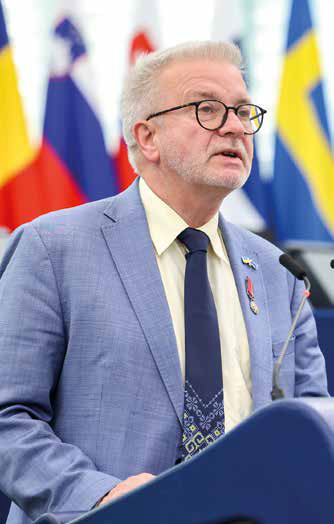by Michael Gahler MEP, European Parliament, Brussels/Strasbourg
On 4 December 1998 in St Malo, Jacques Chirac and Tony Blair provided the initial impulse for the EU’s Common Security and Defence Policy (CSDP). In the St. Malo declaration, both stated the ambition that “the Union must have the capacity for autonomous action, backed up by credible military forces, the means to decide to use them, and a readiness to do so, in order to respond to international crises”. While the declaration reflected the European experience of lacking the proper capacities to handle the challenges of the Balkan wars, NATO perceived it quite sceptically. That led then US Secretary of State, Madeleine K. Albright, to raise concerns with her “three Ds” that need to be avoided: decoupling from the transatlantic partnership, duplication of processes and structures as well as discrimination of non-EU NATO members.
 Europe – a weakening competitor?
Europe – a weakening competitor?
This perception as a potential weakening competitor echoes still today in reactions to the EU’s ambition of strategic autonomy. Additionally, cooperation between the EU and NATO is also hampered by the tensions between Türkiye and Cyprus. While there must be no doubt that NATO is and will remain the cornerstone of our collective defence in the transatlantic area, an EU that is capable of defending itself, alone if necessary, does not weaken NATO. Quite the opposite is true: firstly, due to its regulatory and budgetary instrument the EU has a unique potential as a driver for European capability development and for a stronger European pillar within NATO. Secondly, a militarily capable Europe is a far more attractive partner to the US than a helpless one and can therefore keep the US committed to Europe – while at the same time, we have to acknowledge that the Indo-Pacific region will become the US’ centre of gravity. Thirdly, as there is only a single set of European forces, both organisations are closely linked in practical terms anyway and that requires the EU and NATO to ensure complementarity and interoperability.
Cooperation far behind its potential
However, despite the Berlin Plus Agreement that allows EU access to NATO’s command structures for CSDP operations, three joint EU-NATO declarations and a set of 74 common measures, cooperation still lacks far behind its potential and what is needed in these times. There are islands of hope such as interlinking efforts in military mobility through participation of the US, Canada, Norway and the UK in a PESCO project, also illustrating that that there is no intention of the EU to decouple from NATO. The EU-NATO Structured Dialogue on Resilience and the joint task force for the protection of critical infrastructure are further examples. Nonetheless, tangible cooperation mostly rests at the staff level and, politically, things remain difficult as the delay of the third joint EU-NATO declaration which was announced for the end of 2021 shows.
These political difficulties make a certain degree of duplication necessary, especially an EU command structure that enables us to defend our citizens and interests if access to NATO structures is blocked. On the other hand, we can also observe that NATO is duplicating EU measures. The NATO Innovation Fund (NIF), for instance, aims to boost technological innovation like the European Defence Fund (EDF) does. Remarkably, 20 of the 23 participating NATO Member States are also EU Member States while the US and Canada are not participating. Furthermore, one could also question the potential impact of the NIF with a financial envelope of €1bn over 15 years in comparison to the EDF that has a still too limited budget of €8bn for seven years. While one could argue for possible synergies by both institutions being engaged in similar areas, there is also a substantial risk of incoherent, incompatible and unnecessarily costly outcomes.
Develop a stronger interaction
Facing a war on the EU’s and NATO’s eastern flank, renewed violence in the Middle East, instability in the Balkans, the EU needs to tremendously increase its defence efforts and we need to develop an even stronger interaction between the EU and NATO. To that end, we should revive the ambition of establishing a European corps as laid out in the 1999 Helsinki Headline Goal, integrate this force in the new NATO force model and link the military structure of both organisations by a double-hatted Director General of the EU Military Staff and EU Deputy SACEUR within NATO. Only united will the west be ready to face the challenges of a world that is increasingly becoming insecure. Therefore, we cannot afford to waste any more time.
Michael Gahler MEP
has been a Member of the European Parliament since April 1999. He is currently a member of and the EPP Group’s coordinator in the Foreign Affairs Committee (AFET), the European Parliament’s Standing Rapporteur on Ukraine, a substitute member of the Security and Defence Subcommittee (SEDE) and a substitute member of the Transport and Tourism Committee (TRAN).






